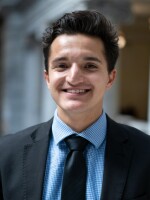When the ski season begins in the Wasatch Back this winter, Deer Valley’s East Village will have 10 chairlifts, 100 new runs and roughly 2,000 acres of new terrain. It’s the second phase of an expansion project that makes the resort one of the largest in North America.
Chris Cushing knows his way around the project. He is a mountain planner and principal with the ski area consulting firm SE Group, which helped Deer Valley launch in 1981 and works with resorts around the world.
Most recently, he designed the East Village’s new runs and developed the plans for its snowmaking system.
“It will be by far the most sophisticated snowmaking system in the country with automation, and the latest technology and fan guns and pump control,” he said on KPCW’s “Local News Hour” Aug. 8 “It’s really going to be an amazing system that has very strong fire power.”
Snowmaking is a fairly simple enterprise, he said. First, pressurized water gets pushed through what’s called a nucleator, a small nozzle that breaks the fluid into the tiny ice crystals. Larger drops of water then cling to those crystals and are blown onto the slopes as artificial snow.
Cushing said machine-made snow isn’t as smooth and silky as Mother Nature’s snowflakes, but its quality has improved as technology has changed.
“I think skiers are going to recognize it,” he said. “Literally, these new guns do produce better snow than the early on guns, so it’s going to be really well received, I’m sure.”
One typical challenge for ski resorts is that they often have limited access to the water needed for snowmaking, Cushing said.
But East Village sits just across the highway from Jordanelle Reservoir and Cushing said its developer, Extell, was able to secure enough water rights to ensure the resort will have robust supply.
Climate and elevation also factor into snowmaking. The East Village base sits more than 500 feet lower than Deer Valley’s Snow Park base, but that doesn’t mean it’s warmer, Cushing said.
Research by a snowmaking engineer found that historically, temperatures on the East Village side of the mountain were the same, or colder.
“From a snowmaking perspective, the climate and temperatures and humidity and everything are very good for snowmaking,” he said. “You know, the lower elevation has more of an impact in the late season, when it’s starting to warm up, and can have a little more effect on the snow.”
Cushing said about 70% of the new runs will have snowmaking coverage from top to bottom.
He said snowmaking typically starts late October or early November, covering all of the terrain through Christmas.


